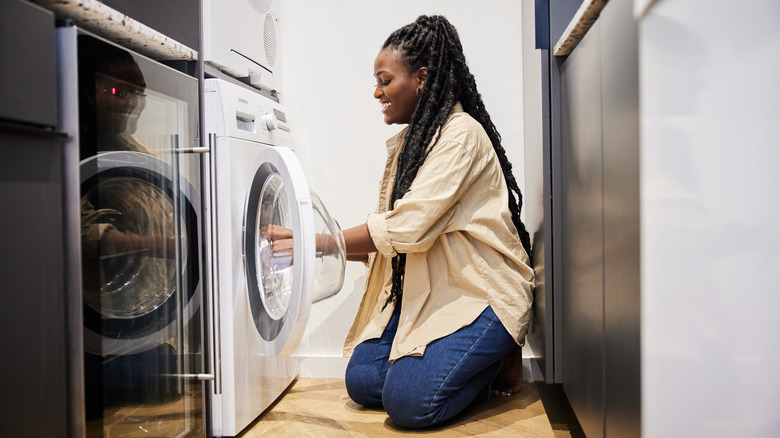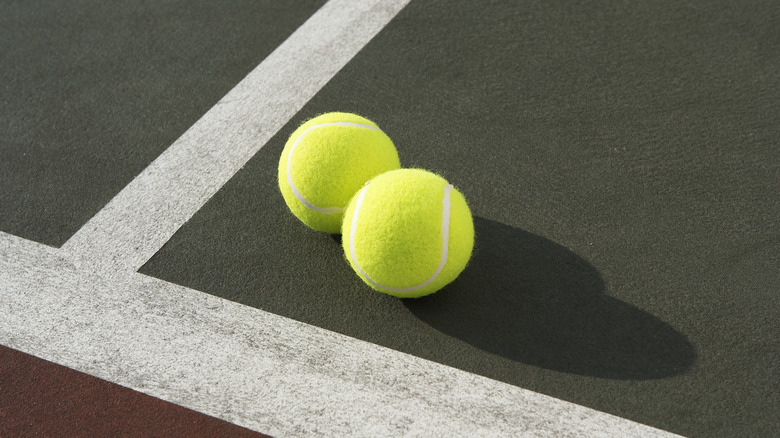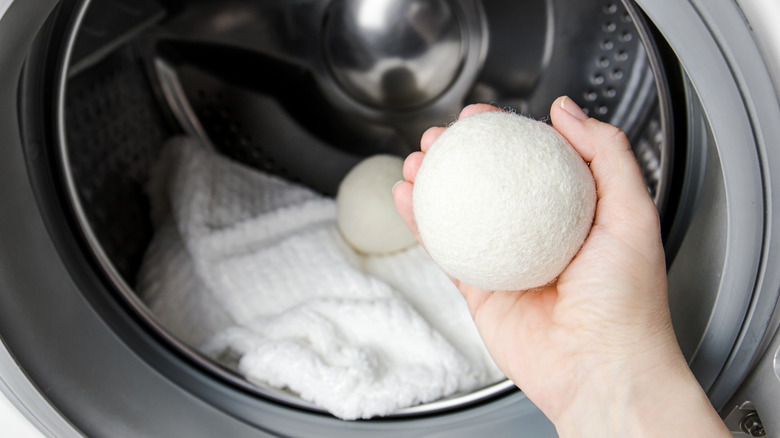A Couple Tennis Balls Is All You Need To Speed Up Your Laundry's Dry Time
Dryer balls are an ordinary sight inside many laundry rooms, used to quicken drying times and improve the appearance of laundry after washes. Usually made from wool or plastic, these accessories have spread rapidly across grocery stores, supermarkets, and online marketplaces over the past few years, marketed to consumers disappointed with the outcome of their dried clothing and craving an alternative to single-use dryer sheets or fabric softener. If you're looking to get in on the dryer ball trend, save your money and avoid a trip to the store by opting to use a common house find instead: tennis balls. Adding two tennis balls to your damp laundry may help it dry faster, while also reducing wrinkles and fluffing the contents of your load.
Although substituting tennis balls for store-bought dryer balls may seem like a fun experiment to test with your wet laundry, it's important to note that the popular sports balls don't serve as exact replacements. In other words, your laundry may not have the same results when using tennis balls in place of products specifically designed to be paired with your dryer. However, it's up to you to determine if the trade-off is worth the potential risk in quality, much of which depends on the characteristics of your dryer and the details of your drying routine.
How it works
Tennis balls work their magic by doing what they do best: bouncing. When placed inside your dryer for a cycle, the balls jounce around, ricocheting off the inside of the appliance's walls and wedging themselves in between the contents of your load. Ultimately, the tennis balls prevent the items inside the dryer from clumping together while it's in motion. With linens and articles of clothing able to remain separated throughout the course of the cycle, the load requires less time to fully dry while avoiding static cling.
Not only do the balls speed up your load's drying time, but they re-fluff your pieces after flattening over time, which may prove especially handy when drying towels, comforters, or pillows. The balls also prevent your laundry from ending up wrinkled, which can cut down on your time spent ironing, as well. To achieve the best results, adjust the number of tennis balls you add to your dryer according to the size and weight of the load. Similar to dryer balls, larger loads may require more tennis balls, while lighter loads may call for just two or three.
Tennis balls or dryer balls?
Tennis balls act as a viable substitute for store-bought dryer balls on occasion, but is it safe to rely on the sports balls on a regular basis? While they are indeed fuzzy and bouncy like their woolen counterparts, they do have notable differences that might not make this the best hack for you.
In some cases, the dye from tennis balls may seep onto articles of clothing or linens, especially if the balls being used are new. Tennis balls also come with a distinguishable scent when purchased unused. This scent may intensify and become worse once you toss the ball inside the dryer, impacted by the high temperatures. The odor could then transfer to the laundry as well, which might pose a problem for those looking for a drying method that doesn't involve sacrificing the scent of their detergent or other laundry additives.
Dryer balls, on the other hand, typically lack pesky dyes and come unscented. Though, if you're looking to give a scent to dryer balls you already own, try adding a few drops of essential oils before throwing them into the dryer with your clothes. However, this hack only works with dryer balls made of wool, not plastic. Wool dryer balls also tend to generate less noise in comparison to tennis balls while the dryer is in use.


